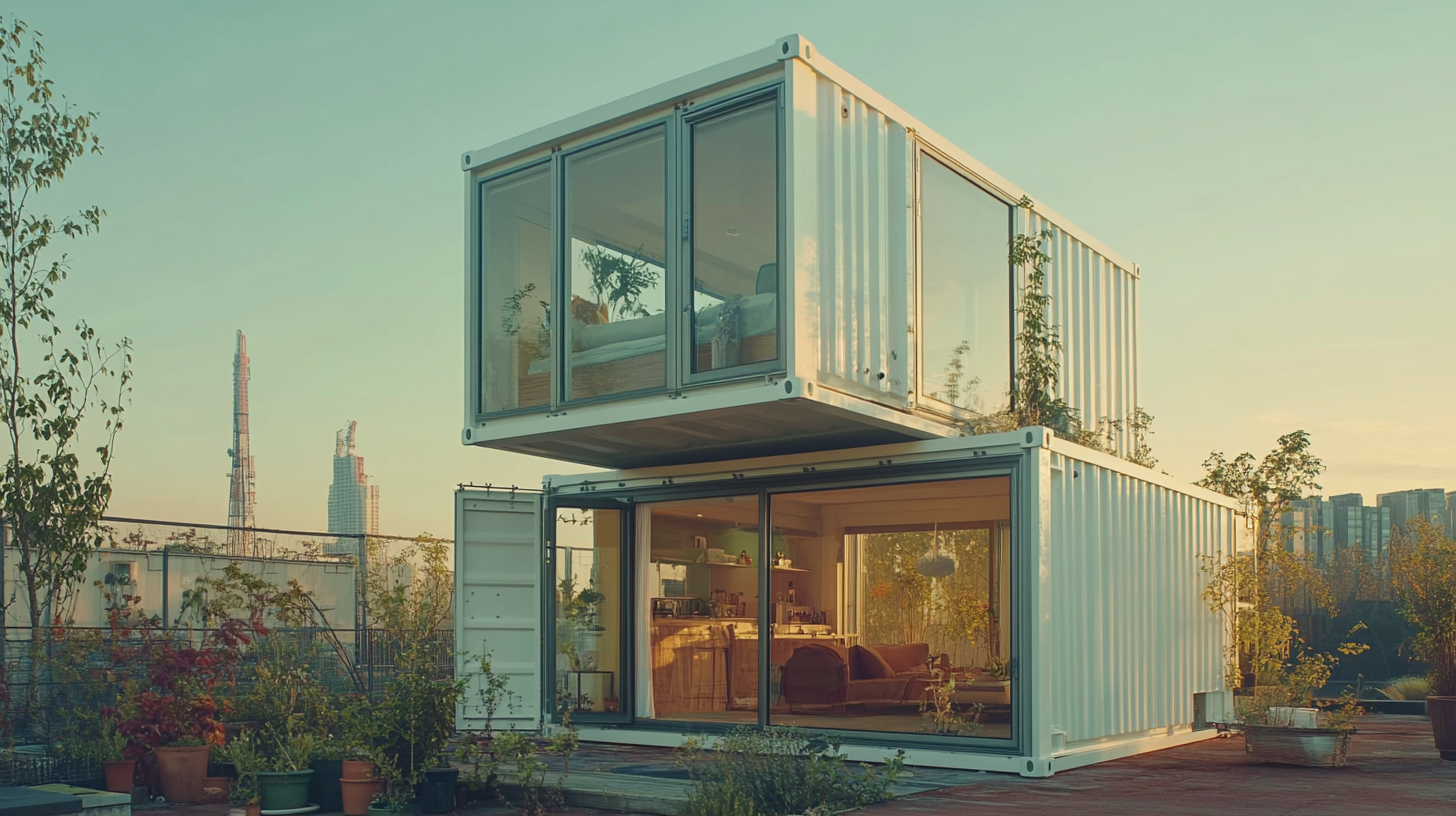In recent years, the demand for sustainable living solutions has surged, driven by the growing awareness of environmental issues and the need for affordable housing. According to a report from the World Economic Forum, the construction industry is responsible for 38% of global carbon emissions, highlighting the urgent need for innovative building practices. One such solution that has gained traction is the use of Modular Shipping Container Homes. These structures not only repurpose the existing surplus of shipping containers but also offer a sustainable alternative to traditional building methods by significantly reducing waste and energy consumption.
As urban populations continue to rise, the search for cost-effective housing solutions has become increasingly critical. The Modular Shipping Container Homes market is projected to grow substantially, with a market report from Research and Markets forecasting an increase in demand primarily due to their affordability, scalability, and environmental benefits. By incorporating eco-friendly designs and alternative energy sources, these homes present a viable path toward achieving both economic and environmental sustainability, thus transforming the landscape of modern living.

Modular shipping container homes have emerged as a groundbreaking solution for sustainable living, driven by a need for affordable housing and environmental responsibility. The concept takes advantage of repurposing industrial materials and has been gaining traction in various urban and rural settings. According to a report by Grand View Research, the global modular construction market is expected to reach $157 billion by 2023, highlighting a significant shift towards innovative building methods that prioritize efficiency and sustainability. The flexibility of modular designs allows for the creation of diverse living spaces, catering to various needs and lifestyles. A single shipping container can be transformed into a compact studio or combined with multiple units to create larger family homes. In fact, a study by the World Economic Forum suggests that using upcycled materials, such as shipping containers, can result in a carbon footprint reduction of up to 90% compared to traditional construction methods. This statistic underscores the potential for modular shipping container homes to contribute meaningfully to sustainable living practices. Moreover, the durability and strength of shipping containers make them a practical choice for housing in various climates, requiring minimal maintenance over time. A report from the U.S. Department of Housing and Urban Development highlights that adopting modular construction could reduce building time by 30% to 50%, allowing for quicker occupancy and alleviating housing shortages in many regions. By embracing this innovative approach, we can explore a new frontier in housing that aligns with sustainable development goals while addressing pressing housing needs.

Shipping container homes have emerged as a revolutionary solution for sustainable living, blending affordability with innovative design. As the world seeks more environmentally friendly housing options, these modular structures provide the perfect answer. Not only are they often more cost-effective than traditional homes, but their construction also repurposes materials that might otherwise end up in landfills. This low-impact approach drastically reduces the ecological footprint associated with new home building.
The benefits of shipping container homes extend beyond their initial financial savings. With a variety of designs available, from minimalist aesthetics to complex architectural configurations, these homes can be tailored to individual needs and preferences. Furthermore, shipping containers are incredibly durable and can withstand extreme weather conditions, making them a viable option for diverse climates. Their modular nature allows for easy expansion, meaning homeowners can adapt their living spaces as their needs change.
Additionally, shipping container homes contribute to a sense of community and sustainability. Many developments incorporate shared green spaces and promote eco-friendly practices, encouraging residents to engage with one another in a way that traditional neighborhoods often do not. By choosing a shipping container home, individuals not only invest in a stylish, cost-effective dwelling but also take a step towards a more sustainable lifestyle.

The architectural landscape is witnessing a transformative shift with the integration of modular container homes, driven by groundbreaking design innovations that promote sustainability. According to a report by the McKinsey Global Institute, the construction industry contributes to approximately 39% of global carbon emissions, making the need for eco-friendly alternatives more urgent than ever. Modular shipping container homes present a viable solution, utilizing repurposed materials to minimize environmental impact while optimizing space.
One of the notable design innovations in modular container architecture is the ability to customize and expand living spaces seamlessly. With dimensions that can be easily transformed, these homes can be designed to accommodate various lifestyles and family sizes. Research from the World Economic Forum highlights that prefabricated construction methods can reduce waste by up to 90%, further emphasizing the sustainability factor. By employing advanced building techniques and energy-efficient technologies, these homes not only reduce the carbon footprint but also lead to considerable cost savings over traditional methods.
Additionally, the aesthetic versatility of container homes is revolutionizing perceptions about sustainable living. Architects are leveraging creative design strategies to enhance the appeal of these structures, often incorporating green roofs, solar panels, and smart home technologies. As noted in a study by BuildingGreen, homes utilizing energy-efficient designs can significantly decrease utility costs, incentivizing a more sustainable lifestyle. With such innovations, modular shipping container homes are establishing themselves as a practical choice for modern living, harmonizing both functionality and environmental consciousness.

The concept of modular shipping container homes has gained momentum in recent years, particularly due to their cost-effectiveness and affordability. These homes, constructed from repurposed shipping containers, offer a sustainable alternative to traditional housing. One major advantage is the reduced construction costs; using containers as the main structure significantly lowers material expenses. Additionally, their portability means fewer logistical costs associated with transportation and installation.
Moreover, container homes present opportunities for eco-conscious living without sacrificing style or comfort. The compact design encourages efficient use of space, minimizing waste while maximizing functionality. Many builders are now incorporating energy-efficient technologies, such as solar panels and green insulation, making these homes even more affordable in the long run through reduced energy costs.
Living in a container home can also lead to lower overall maintenance expenses. The steel structure is durable and resistant to many common issues such as termites or rot, which can plague traditional homes. This longevity, combined with lower initial investment, makes these innovative living solutions appealing to both first-time buyers and seasoned homeowners looking for a budget-friendly housing option. With their unique blend of sustainability and affordability, modular shipping container homes are redefining modern living.
The use of shipping containers as a sustainable housing solution has gained significant traction over the past decade. According to a report from the UK-based “Container Homes Market,” converting shipping containers into homes can help reduce construction waste by approximately 75%. This is a promising statistic given that around 2 billion tons of construction waste is produced annually worldwide. By repurposing these steel structures, we can effectively minimize landfill pressure while addressing housing shortages.
Furthermore, the environmental impact of shipping container homes extends beyond waste reduction. A lifecycle analysis conducted by the Green Building Council indicates that the carbon footprint of container homes is up to 30% lower than that of traditional construction methods. This is largely due to the reduced materials needed and the faster construction times associated with modular designs. Additionally, these homes can be equipped with energy-efficient systems, further decreasing their overall ecological footprint. The incorporation of solar panels and rainwater harvesting systems can transform shipping container homes into self-sustaining units.
Moreover, adopting shipping containers for housing not only addresses environmental concerns but also promotes a circular economy. With the global population projected to reach nearly 10 billion by 2050, innovative housing solutions like container homes could be vital in accommodating this growth sustainably. The ability to easily transport these modular units leads to reduced energy consumption during delivery and setup, making them an increasingly viable option for ecological living.
